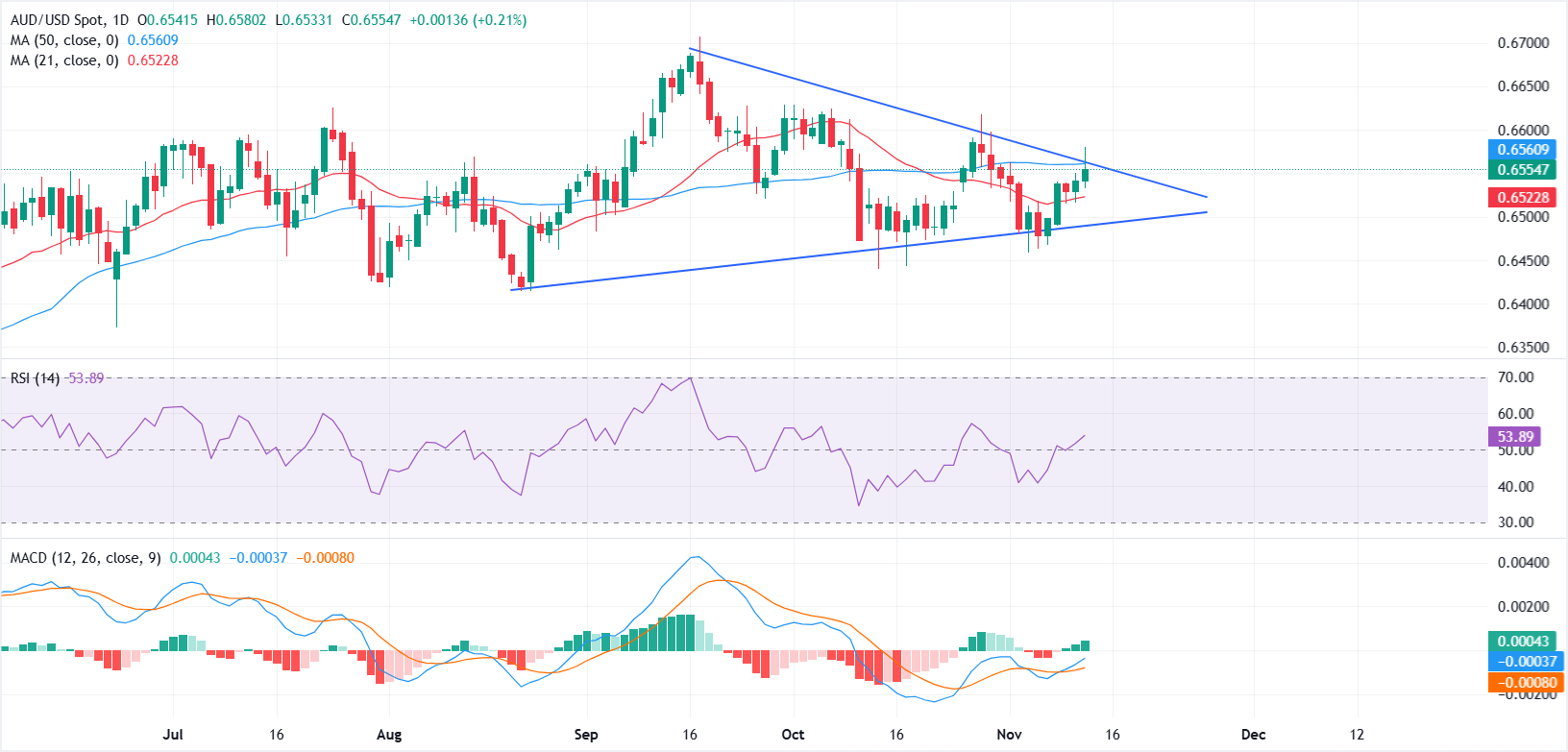AUD/USD Price Forecast: Stalls below 50-day SMA as buyers struggle to extend gains
- AUD/USD retreats modestly from a two-week high as profit-taking offsets earlier gains fueled by upbeat employment data.
- US Dollar remains soft, with DXY down nearly 0.35%, as traders brace for a wave of delayed US economic releases post-shutdown.
- Technically, AUD/USD remains constructive within a symmetrical triangle, with momentum indicators showing early signs of improvement.
The Australian Dollar (AUD) eases slightly against the US Dollar (USD) on Thursday, reversing most of the early advance after briefly climbing to a two-week high on the back of stronger-than-expected employment data. At the time of writing, AUD/USD is holding firm above 0.6550, with the intraday pullback more likely driven by profit-taking rather than any shift in underlying fundamentals.
The broader tone remains constructive as the Greenback stays on the back foot. The US Dollar Index (DXY), which tracks the Greenback’s value against a basket of six major currencies, is trading around 99.10, down nearly 0.35% on the day. Traders are turning cautious as the end of the government shutdown clears the way for a flow of delayed US economic data, which could strengthen the case for another Federal Reserve (Fed) rate cut in December if the releases point to further cooling in the economy.

From a technical perspective, AUD/USD continues to trade inside a well-defined symmetrical triangle on the daily chart. Thursday’s retreat comes after the pair briefly tested the descending trendline resistance, which closely aligns with the 50-day Simple Moving Average (SMA) near 0.6560, where sellers re-emerged.
A decisive break above this confluence would signal a bullish breakout from the triangle, potentially opening the door toward 0.6600 and 0.6700.
On the downside, initial support is seen at 0.6520, aligned with the 21-day SMA. A break below this level exposes the ascending triangle base near 0.6480. A sustained move under 0.6480 would flip the near-term bias bearish, bringing 0.6450 and 0.6400 back into focus.
The Relative Strength Index (RSI) is hovering around 52, reflecting neutral momentum and showing that neither bulls nor bears have firm control. Meanwhile, the Moving Average Convergence Divergence (MACD) indicator is gradually improving, with the histogram turning slightly positive and the signal lines attempting a bullish crossover.
Australian Dollar FAQs
One of the most significant factors for the Australian Dollar (AUD) is the level of interest rates set by the Reserve Bank of Australia (RBA). Because Australia is a resource-rich country another key driver is the price of its biggest export, Iron Ore. The health of the Chinese economy, its largest trading partner, is a factor, as well as inflation in Australia, its growth rate and Trade Balance. Market sentiment – whether investors are taking on more risky assets (risk-on) or seeking safe-havens (risk-off) – is also a factor, with risk-on positive for AUD.
The Reserve Bank of Australia (RBA) influences the Australian Dollar (AUD) by setting the level of interest rates that Australian banks can lend to each other. This influences the level of interest rates in the economy as a whole. The main goal of the RBA is to maintain a stable inflation rate of 2-3% by adjusting interest rates up or down. Relatively high interest rates compared to other major central banks support the AUD, and the opposite for relatively low. The RBA can also use quantitative easing and tightening to influence credit conditions, with the former AUD-negative and the latter AUD-positive.
China is Australia’s largest trading partner so the health of the Chinese economy is a major influence on the value of the Australian Dollar (AUD). When the Chinese economy is doing well it purchases more raw materials, goods and services from Australia, lifting demand for the AUD, and pushing up its value. The opposite is the case when the Chinese economy is not growing as fast as expected. Positive or negative surprises in Chinese growth data, therefore, often have a direct impact on the Australian Dollar and its pairs.
Iron Ore is Australia’s largest export, accounting for $118 billion a year according to data from 2021, with China as its primary destination. The price of Iron Ore, therefore, can be a driver of the Australian Dollar. Generally, if the price of Iron Ore rises, AUD also goes up, as aggregate demand for the currency increases. The opposite is the case if the price of Iron Ore falls. Higher Iron Ore prices also tend to result in a greater likelihood of a positive Trade Balance for Australia, which is also positive of the AUD.
The Trade Balance, which is the difference between what a country earns from its exports versus what it pays for its imports, is another factor that can influence the value of the Australian Dollar. If Australia produces highly sought after exports, then its currency will gain in value purely from the surplus demand created from foreign buyers seeking to purchase its exports versus what it spends to purchase imports. Therefore, a positive net Trade Balance strengthens the AUD, with the opposite effect if the Trade Balance is negative.

